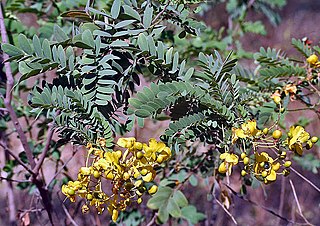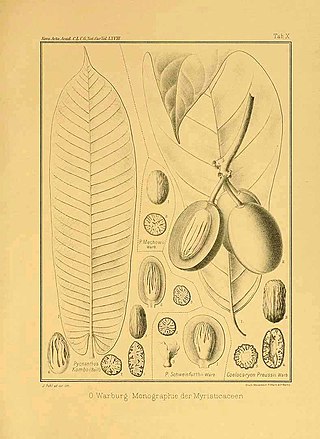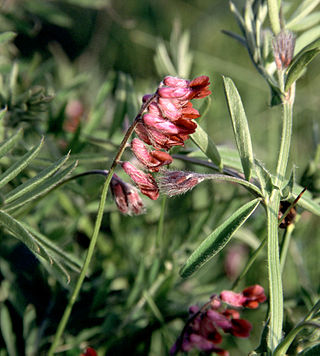
Laburnum, sometimes called golden chain or golden rain, is a genus of two species of small trees in the subfamily Faboideae of the pea family Fabaceae. The species are Laburnum anagyroides—common laburnum and Laburnum alpinum—alpine laburnum. They are native to the mountains of southern Europe from France to the Balkans.

Couroupita guianensis, known by a variety of common names including cannonball tree, is a deciduous tree in the flowering plant family Lecythidaceae. It is native to the tropical forests of Central and South America, and it is cultivated in many other tropical areas throughout the world because of its beautiful, fragrant flowers and large, interesting fruits. Fruits are brownish grey. There are potential medicinal uses for many parts of Couroupita guianensis, and the tree has cultural and religious significance in India. In Sri Lanka, the cannonball tree has been widely misidentified as Sal, after its introduction to the island by the British in 1881, and has been included as a common item in Buddhist temples as a result.

Senna tora is a plant species in the family Fabaceae and the subfamily Caesalpinioideae. Its name is derived from its Sinhala name tora (තෝර). It grows wild in most of the tropics and is considered a weed in many places. Its native range is in Central America. Its most common English name is sickle senna or sickle wild sensitive-plant. Other common names include sickle pod, tora, coffee pod and foetid cassia. It is often confused with Chinese senna or sickle pod, Senna obtusifolia.

Senna, the sennas, is a large genus of flowering plants in the legume family. This diverse genus is native throughout the tropics, with a small number of species in temperate regions. The number of species is estimated to be from about 260 to 350. The type species for the genus is Senna alexandrina. About 50 species of Senna are known in cultivation.

Senna auriculata is a leguminous tree in the subfamily Caesalpinioideae. It is commonly known by its local names matura tea tree, avaram or ranawara, or the English version avaram senna. It is the State flower of Indian state of Telangana. It occurs in the dry regions of India and Sri Lanka. It is common along the sea coast and the dry zone in Sri Lanka.

Erythrina caffra, the coast coral tree or African coral tree, is a tree native to southeastern Africa, which is often cultivated and has introduced populations in California and India. All the 17 species of coral tree in the genus Erythrina are collectively considered the official tree of Los Angeles, California in the United States.

Mursik is a traditional fermented milk variant of the Kalenjin people of Kenya. It can be made from cow or goat milk and is fermented in a specially made calabash gourd locally known as a sotet. The gourd is lined with soot from specific trees, such as the African senna, which add flavor to the fermented milk. It is normally consumed with ugali or on its own and is served at room temperature or chilled.

Psorothamnus schottii is a species of flowering plant in the legume family known by the common name Schott's dalea. It is native to the Sonoran Deserts of northern Mexico and adjacent sections of Arizona and the Colorado Desert in California.
Rupertia hallii is a species of flowering plant in the legume family known by the common name Hall's California tea, or Hall's rupertia. It is endemic to California, where it is known only from a small section of the northern Sierra Nevada foothills on the border between Butte and Tehama Counties. It is a perennial herb approaching a meter in height with slender, leafy branches. The leaves are each made up of three lance-shaped or oval, pointed leaflets measuring up to 9 centimeters long. The inflorescence is a clustered raceme of several whitish or yellowish pealike flowers. Each flower has a tubular calyx of sepals and a corolla spreading to about a centimeter in width. The fruit is a hairy, gland-speckled legume around a centimeter long.

Senna armata is a species of flowering plant in the legume family known by the common names spiny senna and desert senna. It is native to the desert regions around the intersection of Nevada, Arizona, eastern California and northern Baja California, where it grows in sandy and rocky habitat, such as arroyos. It is a shrub growing up to a meter tall, its grooved, branching stems often narrowing to thorns at their tips. The spiny branches are coated in tubular hairs which help protect it from hot desert air. The spine-tipped leaves are each made up of two to four pairs of small leaflets. The leaves are ephemeral, dropping soon after emerging, leaving the shrub naked most of the time. Flowers occur singly or in small clusters in leaf axils. They are fragrant and showy, with five petals in shades of yellow to salmon pink, each measuring roughly a centimeter long. The fruit is a legume pod up to 4 centimeters long.

Senna multiglandulosa is a species of flowering plant in the legume family known by several common names, including glandular senna, downy senna, and buttercup bush. It is native to Mexico, Guatemala, and western parts of South America, but it is widely cultivated as an ornamental plant and in some areas of the world has become naturalized in the wild. In some places it is considered a weed, for example, in New Zealand and New South Wales.

Sphaerophysa salsula is a species of flowering plant in the legume family known by the common names alkali swainsonpea, Austrian peaweed, and red bladder-vetch. It is native to Asia but it is known in many other parts of the world as an introduced species and often a noxious weed. It grows in cultivated land and disturbed habitat, easily tolerating alkaline substrates. It is commonly seen in areas where alfalfa is grown, because the seeds of the two species look similar and the weed seed is easily imported with the crop seed.

Pycnanthus angolensis is a species of tree in the nutmeg family, Myristicaceae. It is native to Tropical Africa. Its English language common names include African nutmeg, false nutmeg, boxboard, and cardboard. In Africa it is widely known as ilomba.

Veronica anagallis-aquatica is a species of flowering plant in the family Plantaginaceae known by the common names water speedwell, blue water-speedwell,brook pimpernel, and sessile water-speedwell. It is also listed as Veronica catenata. Its true native range is not clear, but the plant is present on most continents, and in most places it is probably naturalized. It occurs in many types of moist and wet habitat, and it is semi-aquatic, often growing in shallow water along streambanks, in ponds, and in other wetland environments. It is a rhizomatous perennial herb with stems growing 10 centimeters to about a meter in maximum length. It may be decumbent, the stem spreading along the ground and rooting where it touches moist substrate, or erect in form. The oppositely arranged leaves are green, smooth-edged or toothed, and sometimes clasping the stem where the leaf pairs meet at the bases. The inflorescence is a raceme of many flowers arising from the leaf axils. Each flower is borne on a short, curving pedicel. The flower corolla is up to a centimeter wide with four lobes, the upper lobe being widest. It is blue, lavender, or violet with purple lines near the base of each lobe. At the center are two small protruding stamens.

Vicia benghalensis is a species of vetch known by the common names purple vetch and reddish tufted vetch. It is native to southern Europe, North Africa, and nearby islands, and it is utilized elsewhere in agriculture and may be present in the wild as an introduced species. It is an annual herb with a climbing stem which is coated in hairs, often densely, making the plant appear silvery white. Each leaf is made up of several pairs of elongated leaflets which measure up to 3 centimeters in length. The inflorescence is a one-side raceme of several dark reddish purple flowers. Each flower has a densely hairy calyx of sepals and a tubular corolla between one and two centimeters in length. The fruit is a flat, hairy legume pod up to 3.5 centimeters long containing multiple seeds.

Vicia nigricans is a species of vetch known by the common name black vetch. It has a disjunct distribution, its two subspecies divided by thousands of miles in range. The northern subspecies, ssp. gigantea, is native to western North America from Alaska to northern California, where it occurs in coastal and moist inland habitat and disturbed areas. The southern subspecies, ssp. nigricans, occurs in southern South America, in Argentina and Chile.

Senna italica, the Port Royal senna, Italian senna, or Senegal senna is a legume tree in the genus Senna. It is recognized by many other common names based on the regions it grows in. In India, it is used to produce a powder for treating hair-related diseases which is known as “neutral henna”. Whereas, in some parts of the world, this species is cultivated for the leaves which yield the drug senna, known commonly as Senna glycoside, which in turn is the base for a laxative. Senegal senna is easily distinguishable through its many distinctive features. There are 3 subspecies of this plant based on the size of the inflorescence and the length of the petiole. The subspecies are italica, micrantha, and arachoides. In many regions, this plant is cultivated commercially and medicinally.

Aeschynomene americana is a species of flowering plant in the family Fabaceae (legume) known by many common names, including shyleaf, forage aeschynomene, American joint vetch, thornless mimosa, bastard sensitive plant (Jamaica), pega pega, pega ropa, antejuela, ronte, cujicillo, and dormilonga. It is native to Central America, parts of South America, the West Indies, and Florida. It is now found in the US, in Australia and in South-East Asia.

Rhynchosia minima is a species of flowering plant in the legume family known by the common names least snout-bean, burn-mouth-vine, and jumby-bean. It can be found on every continent. It is naturalized in Hawaii.

Alysicarpus vaginalis is a species of flowering plant in the legume family, Fabaceae. It is native to parts of Africa and Asia, and it has been introduced to other continents, such as Australia and the Americas. It is cultivated as a fodder for livestock, for erosion control, and as a green manure. Common names include alyce clover, buffalo clover, buffalo-bur, one-leaf clover, and white moneywort.



















